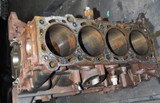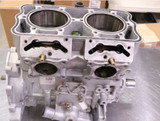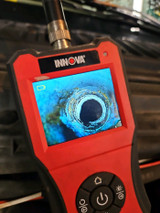Frequently Asked Questions (FAQs) on Car Overheating and Blown Head Gaskets
Modern car engines are made with a combination of materials, including aluminum and plastic, for various reasons, primarily related to performance, efficiency, and weight reduction. Here are some of the key reasons for using these materials:
- Aluminum:
- Lightweight: Aluminum is much lighter than iron, which was commonly used in older engines, although there are some cast iron blocks around still. One example being some Chevy LS engines. Lighter engines improve fuel efficiency and reduce the overall weight of the vehicle, which can improve performance, handling and fuel mileage.
- Heat Dissipation: Aluminum has good heat dissipation properties, which helps in cooling the engine. Efficient cooling is crucial to prevent overheating and engine damage.
- Corrosion Resistance: Aluminum is less susceptible to corrosion compared to iron. This leads to longer engine life and less maintenance. One drawback is that aluminum engine blocks and cylinder heads can begin to experience problems with distortion and cause head gasket failure, at lower temperatures compared to cast iron.
- Plastic:
- Weight Reduction: Plastic components, such as intake manifolds, valve covers, and various engine covers, are used to reduce weight further while maintaining necessary functionality.
- Design Flexibility: Plastic can be molded into complex shapes, allowing for innovative and efficient designs that might not be possible with other materials.
- Noise and Vibration Dampening: Some plastic components are used for noise and vibration dampening, improving the overall comfort and quietness of the vehicle.
The normal operating temperature of a car engine typically ranges from about 195 to 220 degrees Fahrenheit (90 to 105 degrees Celsius). This temperature range ensures that the engine operates efficiently while avoiding overheating. Maintaining a proper operating temperature is essential for engine performance and longevity. The engine's cooling system, including the radiator, thermostat, water pump, and cooling fan, helps regulate and control the engine's temperature.
Below are some FAQ's that may car owners have when dealing with an overheating vehicle.
1. Why does my car overheat?
- Answer: Car overheating can result from various factors, including a malfunctioning cooling system, low coolant levels, a faulty thermostat, a clogged radiator, or a failing water pump. Although not as common, low engine oil can also cause an overheat. It's essential to diagnose the specific cause to prevent further damage. A visual inspection and pressure testing is a good place to start when diagnosing the problem.
2. What are the signs of an overheating car?
- Answer: Signs of an overheating car may include the temperature gauge in the red zone, steam or smoke from the engine, a strong odor of coolant, loss of engine power, and warning lights on the dashboard. A/C not cooling may also indicate the engine is overheating. Pull over and turn off the engine immediately if you notice these signs. Continuing to drive may be a very costly mistake.
3. What is a blown head gasket, and what causes it?
- Answer: A blown head gasket is a severe engine problem where the gasket between the cylinder head and the engine block fails. This can be caused by overheating, which warps the cylinder head or engine block, and may also result from a manufacturer's defect or natural wear and tear over time. Failed head bolt threads may occur causing the blown head gasket or the threads may fail sometimes due to the extreme temperatures softening the aluminum.
4. Can an overheating engine lead to a blown head gasket?
- Answer: Yes, it can. When an engine overheats, it can cause the metal components like the cylinder head and engine block to expand and contract rapidly. This can weaken the head gasket over time and eventually lead to a failure, causing a blown head gasket.
5. What are the symptoms of a blown head gasket?
- Answer: Symptoms of a blown head gasket may include white smoke from the exhaust, overheating, coolant loss with no external leaks, oil appearing milky or frothy, poor engine performance, and rough idling. Burning coolant has a very distinct odor, ask any experienced auto technician. These signs often indicate a compromised head gasket.
6. How is a blown head gasket diagnosed?
- Answer: A mechanic can diagnose a blown head gasket through various methods, including a compression test, a leak-down test, a cooling system pressure test, and a carbon test to see if there's exhaust gases in the cooling system. Of course upon tear-down of the engine a visual inspection of the gasket is done. These tests help determine if there's a problem with the gasket.
7. Can I drive with a blown head gasket?
- Answer: It is not advisable to drive with a blown head gasket. For reasons already mentioned above, continuing to operate the vehicle can lead to severe engine damage and costly repairs. It's best to have the issue addressed as soon as possible.
8. How is a blown head gasket repaired?
- Answer: Repairing a blown head gasket typically involves disassembling the top of the engine, replacing the gasket, and inspecting and potentially resurfacing the cylinder head and engine block if they are damaged. It's a complex and labor-intensive process that should be performed by a qualified mechanic. It's important to notice if any head bolt threads are loose upon disassembly. This could be a clue that the threads have pulled in the block. Time Sert makes kits to make this repair without replacing the block or entire engine.
9. Can preventative maintenance prevent overheating and blown head gaskets?
- Answer: Regular maintenance, such as checking and maintaining coolant levels, changing the thermostat, and inspecting the cooling system, can help prevent overheating and, in turn, reduce the risk of a blown head gasket. Following the manufacturer's recommended maintenance schedule is a good idea. Most importantly is to pay attention to the temperature gauge. Driving just a little further can cause damage quickly.
10. How can I prevent my car from overheating and protect against blown head gaskets?
- Answer: To prevent overheating and protect against blown head gaskets, maintain your vehicle's cooling system, keep an eye on the temperature gauge, avoid overheating the engine, and address any cooling system issues promptly. Regular maintenance and attentive driving habits can go a long way in avoiding these problems.
Since 2005, Wise Auto Tools has been providing customers with specialty tools and Time Sert thread repair kits. If you have experienced failed head bolt threads in the block of your engine and are unsure of which thread repair kit is the best fit for your specific application, contact to us for assistance. By calling our toll-free number at 800-734-8665 or filling out our Contact Form, our team of experts can help you choose the appropriate kit. Our goal is to ensure that you have the tools and support you need to successfully complete your project with ease and confidence.
Recent Posts
-
Shorter Kits for Head Bolt Thread Repair - What are the downsides?
We recently came across an article that stated the more expensive, longer Time Sert kits made for he …28th Feb 2024 -
Polaris Head Bolt Thread Repair Kit - Information and Recommended Kit & Inserts
Aluminum head bolt threads pulling out on Polaris engines is a fairly common problem. Installing a s …23rd Jan 2024 -
How Bad Can Spark Plug Hole Erosion Get, and Can It Be Fixed?
How severely can a spark plug hole in an aluminum engine head, which previously had a repair insert …5th Dec 2023




